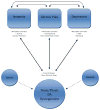The comorbidity of insomnia, chronic pain, and depression: dopamine as a putative mechanism
- PMID: 22748562
- PMCID: PMC3519938
- DOI: 10.1016/j.smrv.2012.03.003
The comorbidity of insomnia, chronic pain, and depression: dopamine as a putative mechanism
Abstract
Epidemiological, cross-sectional, and prospective studies suggest that insomnia, chronic pain, and depression frequently co-occur and are mutually interacting conditions. However, the mechanisms underlying these comorbid disorders have yet to be elucidated. Overlapping mechanisms in the central nervous system suggest a common neurobiological substrate(s) may underlie the development and interplay of these disorders. We propose that the mesolimbic dopamine system is an underappreciated and attractive venue for the examination of neurobiological processes involved in the interactions, development, exacerbation, and maintenance of this symptom complex. In the present article, studies from multiple disciplines are reviewed to highlight the role of altered dopaminergic function in the promotion of arousal, pain sensitivity, and mood disturbance. We argue that studies aiming to elucidate common factors accounting for the comorbidity of insomnia, chronic pain, and depression should evaluate functioning within the mesolimbic dopaminergic system and its effect on common processes known to be dysregulated in all three disorders.
Copyright © 2012 Elsevier Ltd. All rights reserved.
Conflict of interest statement
The authors declare no conflicts of interest.
Figures

References
-
- Ohayon MM. Epidemiology of insomnia: what we know and what we still need to learn. Sleep Med Rev. 2002;6:97–111. - PubMed
-
- Ohayon MM. Relationship between chronic painful physical condition and insomnia. J Psychiatr Res. 2005;39:151–9. - PubMed
-
- Kelly GA, Blake C, Power CK, O’Keefe D, Fullen BM. The association between chronic low back pain and sleep: a systematic review. Clin J Pain. 2011;27:169–81. - PubMed
-
- Menefee LA, Cohen MJ, Anderson WR, Doghramji K, Frank ED, Lee H. Sleep disturbance and nonmalignant chronic pain: a comprehensive review of the literature. Pain Med. 2000;1:156–72. - PubMed
-
- Smith MT, Haythornthwaite JA. How do sleep disturbance and chronic pain inter-relate? Insights from the longitudinal and cognitive-behavioral clinical trials literature. Sleep Med Rev. 2004;8:119–32. - PubMed
Publication types
MeSH terms
Substances
Grants and funding
LinkOut - more resources
Full Text Sources
Other Literature Sources
Medical

